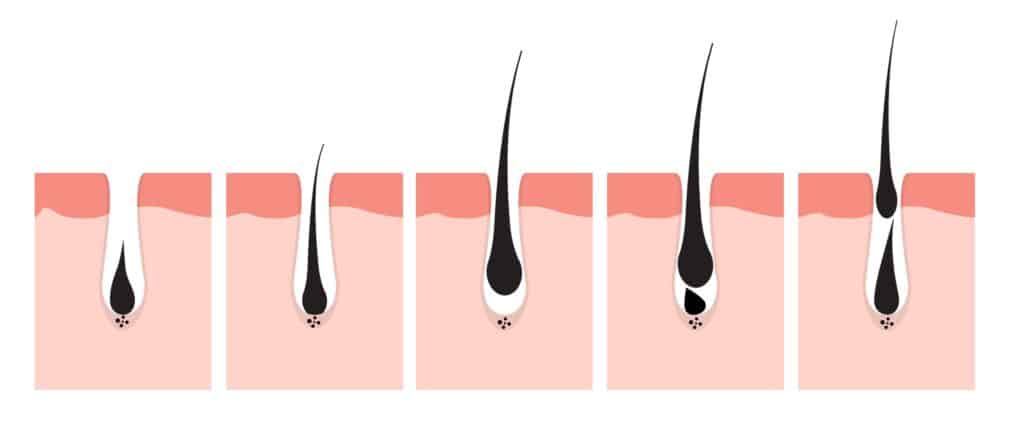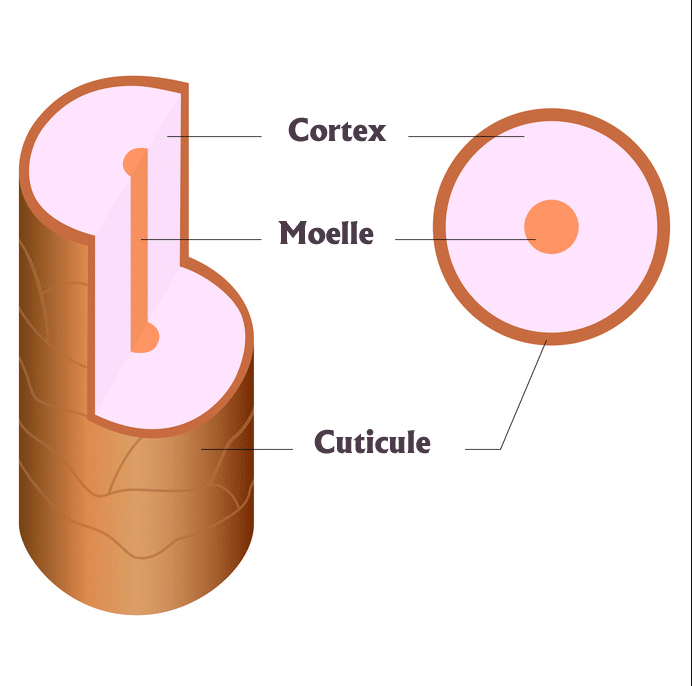Hair is a silent witness to our history, our health and our genetic heritage. Each strand that adorns our heads is the fruit of a complex anatomy composed mainly of keratin and containing secrets that science continues to explore. Discover everything you need to know about hair anatomy, its different layers, its components and its life cycle.
What is the composition of hair?
The hair is a complex biological structure composed mainly of proteins, water, lipids, minerals and pigments.
La keratin is the main protein making up hair. It represents approximately 95% hair composition. Keratin is a protein the fibrous structure that gives hair its strength, resilience and structure.
Healthy hair also contains an average of 10-15% of water. Water also plays an essential role in the hair's biochemical processes.
Lipids present in the hair have several functions, including acting as a protective barrier and adding shine. They largely come from the sebaceous glands, which produce sebum, an oily substance that lubricates the scalp and hair.
Hair also contains various minerals, including zinc, iron, copper and magnesium, which play a role in hair structure and colour. These minerals can also reflect environmental exposure to certain elements, making hair a good biomarker for toxicological analyses.
Finally, hair is made up of pigments. Pigments are responsible for hair colour. The main pigments are eumelanin (which gives black or brown tones) and pheomelanin (responsible for red and blonde tones). The combination and concentration of these pigments, combined with the structure of the hair, determine the final hair colour.
What is the structure of hair?
The hair shaft
La hair shaft is the part of the hair that you can see and touch, in other words the part that emerges from the scalp. The structure of the hair shaft is finely designed and made up of several layers that give it its unique properties:
- La cuticle : This is the outer layer of the hair. It is made up of flattened, overlapping cells, similar to scales. These scales interlock and protect the underlying layer, the cortex. A healthy, intact cuticle gives hair a smooth, shiny appearance, while a damaged cuticle can make hair dull, rough and more prone to tangling.
- The cortex : This is the middle and thickest layer of the hair shaft. It is made up of long cells containing keratin. It is in the cortex that the pigments responsible for hair colour are found. This layer is crucial to the hair's strength, elasticity and texture.
-
- La marrow : this central layer is not always present, particularly in fine hair. When it is present, it is often discontinuous. The exact function of the medulla in the hair shaft is not fully understood, but it may play a role in transporting nutrients.
The hair follicle
Although the hair shaft or the visible part of the hair, its true origin lies deeper down, in the hair follicle nested in the dermis of the skin, the follicle is the living "root" of the hair, where the cells divide and keratinise to form the hair shaft. The follicle is also home to the dermal papilla, a structure rich in blood vessels that supply the nutrients needed for hair growth.
Sebaceous glands
The sebaceous glands play an essential role in the health of the scalp and hair. Located close to the surface of the skin and closely associated with the hair follicles, these glands are responsible for producing sebum.
The sebum lubricates the scalp and hair, keeping them hydrated and protected from the elements. It also creates a hydrophobic barrier on the skin, reduces water loss and protects against external aggression such as bacteria and fungi. This natural oil also helps to maintain the flexibility of the hair shaft and gives it a shiny appearance.
An excessive sebum production can lead to scalp and skin problems. greasy hair. Conversely, a insufficient sebum production leaves the scalp and dry hair and therefore likely to become brittle. Imbalances in sebum production can be influenced by various factors, such as hormonal changes, diet, stress, certain medications and hair care routines.
What is the life cycle of hair?
Every hair on our head goes through a life cycle, made up of different phases. These phases determine how long a hair remains on the scalp, how long it grows and when it falls out. The cycle is influenced by a number of factorsThese include age, genetics, hormones and even environmental factors. Visit hair life cycle includes three main phases: anagen, catagen and telogen :
- La anagen phase : the anagen phase is the period of active hair growth. It is during this phase that the hair follicle cells divide rapidly to form the hair shaft. The anagen phase lasts between 2 and 7 years. During this phase, a hair can grow by around 1 to 1.5 cm per month.
- La catagen phase : the catagen phase lasts approximately 2 to 3 weeks. This is a short transitional phase during which the hair stops growing and the hair follicle retracts. As a result, the hair bulb gradually detaches from the dermal papilla that supplied it with the nutrients it needed to grow.
- La telogen phase : during the telogen stage, the hair is in a state of rest. Although it does not grow, it remains attached to the follicle. At the end of the telogen phase, the hair naturally falls out and a new hair begins to grow, marking the start of a new anagen cycle.
In certain situations, an abnormally high percentage of hair can simultaneously enter the telogen phase, leading to greater-than-normal hair loss. This condition is often triggered by factors such as major stress, illness, surgery, certain medications, iron deficiency, or hormonal upheaval such as after childbirth.

| Start of anagen phase | Anagen phase | Catagen phase | Telogen phase | New cycle |
Some key figures about hair
- The average human scalp contains between 100,000 and 150,000 hair follicles.
- On average, a hair grows 0.3 to 0.5 mm a day, i.e. around 1 to 1.5 cm a month.
- La average lifespan of a hair on the scalp is 2 to 7 years. However, it varies according to the individual and genetic and environmental factors.
- It is normal to lose up to 50 or even 100 hairs a day. This loss is normally compensated for by the growth of new hair, provided that no aggravating factors disrupt the natural renewal process.
- Hair is incredibly strong. It can support a weight of around 100 grams. If you multiply this strength by the average number of hairs, an entire scalp could theoretically support up to 12 tonnes.


